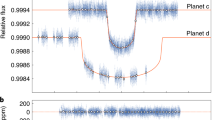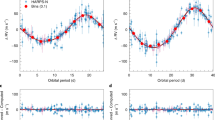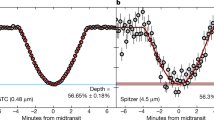Abstract
Of the over 400 known1 exoplanets, there are about 70 planets that transit their central star, a situation that permits the derivation of their basic parameters and facilitates investigations of their atmospheres. Some short-period planets2, including the first terrestrial exoplanet3,4 (CoRoT-7b), have been discovered using a space mission5 designed to find smaller and more distant planets than can be seen from the ground. Here we report transit observations of CoRoT-9b, which orbits with a period of 95.274 days on a low eccentricity of 0.11 ± 0.04 around a solar-like star. Its periastron distance of 0.36 astronomical units is by far the largest of all transiting planets, yielding a ‘temperate’ photospheric temperature estimated to be between 250 and 430 K. Unlike previously known transiting planets, the present size of CoRoT-9b should not have been affected by tidal heat dissipation processes. Indeed, the planet is found to be well described by standard evolution models6 with an inferred interior composition consistent with that of Jupiter and Saturn.
This is a preview of subscription content, access via your institution
Access options
Subscribe to this journal
Receive 51 print issues and online access
$199.00 per year
only $3.90 per issue
Buy this article
- Purchase on Springer Link
- Instant access to full article PDF
Prices may be subject to local taxes which are calculated during checkout




Similar content being viewed by others
References
Schneider, J. The Extrasolar Planets Encyclopedia 〈http://exoplanet.eu/index.php〉 (1999–2010)
Dvorak, R. et al. CoRoT’s first seven planets: An overview. In Proc. “New Technologies for Probing the Diversity of Brown Dwarfs and Exoplanets” (EDP publications, 2009) preprint at 〈http://arxiv.org/abs/0912.4655〉.
Léger, A. et al. Transiting exoplanets from the CoRoT space mission. VIII. CoRoT-7b: the first super-Earth with measured radius. Astron. Astrophys. 506, 287–302 (2009)
Queloz, D. et al. The CoRoT-7 planetary system: two orbiting super-Earths. Astron. Astrophys. 506, 303–319 (2009)
Baglin, A. et al. CoRoT: Description of the Mission and Early Results. IAU Symp. 253, 71–81 (2009)
Guillot, T. The interiors of giant planets: models and outstanding questions. Annu. Rev. Earth Planet. Sci. 33, 493–530 (2005)
Perruchot, S. et al. The SOPHIE spectrograph: design and technical key-points for high throughput and high stability. Proc. SPIE 7014, 70140J (2008)
Deeg, H. J. et al. Ground-based photometry of space-based transit detections: photometric follow-up of the CoRoT mission. Astron. Astrophys. 506, 343–352 (2009)
Mayor, M. et al. Setting new standards with HARPS. ESO Mess. 114, 20–24 (2003)
Israelian, G. et al. Enhanced lithium depletion in Sun-like stars with orbiting planets. Nature 462, 189–191 (2009)
Ibgui, L., Burrows, A. & Spiegel, D. Tidal heating models for the radii of the inflated transiting giant planets WASP-4b, WASP-6b, WASP-12b, and TrES-4. Astrophys. J. (submitted); preprint at 〈http://arxiv.org/abs/0910.4394〉 (2009)
Lammer, H. et al. Determining the mass loss limit for close-in exoplanets: what can we learn from transit observations? Astron. Astrophys. 506, 399–410 (2009)
Miller, N., Fortney, J. J. & Jackson, B. Inflating and deflating hot Jupiters: coupled tidal and thermal evolution of known transiting planets. Astrophys. J. 702, 1413–1427 (2009)
Sudarsky, D., Burrows, A. & Pinto, P. Albedo and reflection spectra of extrasolar giant planets. Astrophys. J. 535, 885–903 (2000)
Showman, A. P. & Guillot, T. Atmospheric circulation and tides of “51 Pegasus b-like” planets. Astron. Astrophys. 385, 166–180 (2002)
Laughlin, G. et al. Rapid heating of the atmosphere of an extrasolar planet. Nature 457, 562–564 (2009)
Exodat Information System. 〈http://lamwws.oamp.fr/exodat/〉.
Bruntt, H. et al. Abundance analysis of targets for the COROT/MONS asteroseismology missions. II. Abundance analysis of the COROT main targets. Astron. Astrophys. 425, 683–695 (2004)
Bruntt, H., De Cat, P. & Aerts, C. A spectroscopic study of southern (candidate) γ Doradus stars. II. Detailed abundance analysis and fundamental parameters. Astron. Astrophys. 478, 487–496 (2008)
Siess, L. Evolution of massive AGB stars. I. Carbon burning phase. Astron. Astrophys. 448, 717–729 (2006)
Sing, D. K. Stellar limb-darkening coefficients for CoRoT and Kepler. Astron. Astrophys. 510, 21–27 (2010)
Mandel, K. & Agol, E. Analytic light curves for planetary transit searches. Astrophys. J. 580, L171–L175 (2002)
Geem, Z. W., Kim, J. H. & Loganathan, G. V. A new heuristic optimization algorithm: Harmony Search. Simulation 76, 60–68 (2001)
Deleuil, M. et al. Exo-Dat: an information system in support of the CoRoT/exoplanet science. Astron. J. 138, 649–663 (2009)
Morel, P. & Lebreton, Y. CESAM: a free code for stellar evolution calculations. Astrophys. Space Sci. 316, 61–73 (2008)
Guillot, T. The composition of transiting giant extrasolar planets. Phys. Scr. 130, 014023 (2008)
Barbieri, M. et al. HD 17156b: a transiting planet with a 21.2 day period and an eccentric orbit. Astron. Astrophys. 476, L13–L16 (2007)
Fossey, S. J., Waldmann, I. P. & Kipping, D. M. Detection of a transit by the planetary companion of HD 80606. Mon. Not. R. Astron. Soc. 396, L16–L20 (2009)
Moutou, C. et al. Photometric and spectroscopic detection of the primary transit of the 111-day-period planet HD 80606 b. Astron. Astrophys. 498, L5–L8 (2009)
Garcia-Melendo, E. & McCullough, P. R. Photometric detection of a transit of HD 80606b. Astrophys. J. 698, 558–561 (2009)
Acknowledgements
The CoRoT space mission has been developed and is operated by CNES, with the contributions of Austria, Belgium, Brazil, ESA, Germany and Spain. CoRoT data are available to the public from the CoRoT archive: http://idoc-corot.ias.u-psud.fr. The team at IAC acknowledges support by grant ESP2007-65480-C02-02 of the Spanish Ministerio de Ciencia e Innovación. The German CoRoT Team (TLS and Univ. Cologne) acknowledges DLR grants 50OW0204, 50OW0603 and 50QP07011. Observations with the HARPS spectrograph were performed under the ESO programme ID 082.C-0120, and observations with the VLT/UVES under ID 081.C-0413(C).
Author Contributions H.J.D. coordinated the analysis and its interpretation. P. Barge., S.A., J.M.A., R.A., J.C., L.C., T.M., M.O., M.P. and B. Samuel contributed to the treatment of the light curve and the detection of the transits in the CoRoT data. F.B., D.Q., C.M., G.H., M.M., C.L., F. Pepe, A.H., W.B., S.A., S.U. and F. Pont prepared, performed and analysed radial velocity observations; A. Baglin, M.A., J.S., L.J., P. Bordé. A. Léger, A. Llebaria and P.B. contributed fundamentally to the definition, design and operation of the CoRoT instrument. A.E., B.T., S.C., R.D., M.F., M.G., M. Hidas, T.L., H.R., D.R., R.S., A.S., H.J.D., R.d.H., R.A., M.R., P.K., B. Stecklum and D.C. performed ground-based photometry; Sz.C., R.A., M.B. and A. S. Bonomo worked on light curve modelling and parameter fitting. M.D., H.B., D.G., J.-C.G., E.G. and M.F. constitute the team that performed the stellar typing and related observations. T.G., M. Havel, J.S., H.L., G.W. and S.F.-M. performed the modelling of the planet and the interpretation of its characteristics. All authors discussed the results and commented on the manuscript.
Author information
Authors and Affiliations
Corresponding author
Ethics declarations
Competing interests
The authors declare no competing financial interests.
Supplementary information
Supplementary Table
This file contains Supplementary Table 1: Measured radial velocities of CoRoT-9. (PDF 78 kb)
Rights and permissions
About this article
Cite this article
Deeg, H., Moutou, C., Erikson, A. et al. A transiting giant planet with a temperature between 250 K and 430 K. Nature 464, 384–387 (2010). https://doi.org/10.1038/nature08856
Received:
Accepted:
Issue Date:
DOI: https://doi.org/10.1038/nature08856
This article is cited by
-
Review on the Role of Planetary Factors on Habitability
Origins of Life and Evolution of Biospheres (2016)
-
The role of space telescopes in the characterization of transiting exoplanets
Nature (2014)
Comments
By submitting a comment you agree to abide by our Terms and Community Guidelines. If you find something abusive or that does not comply with our terms or guidelines please flag it as inappropriate.



